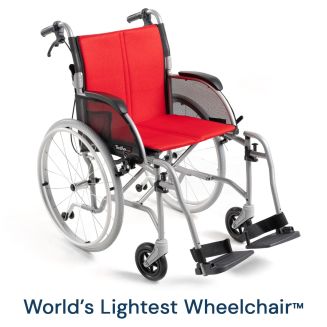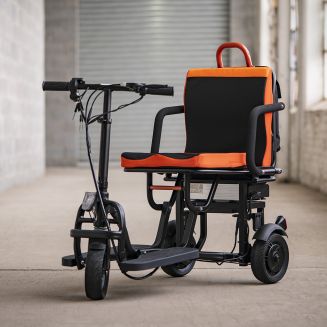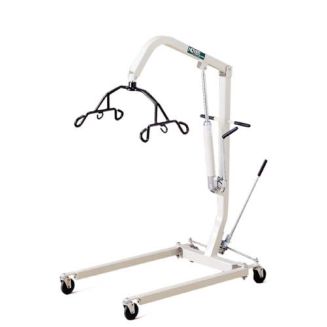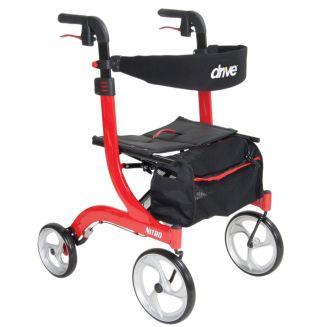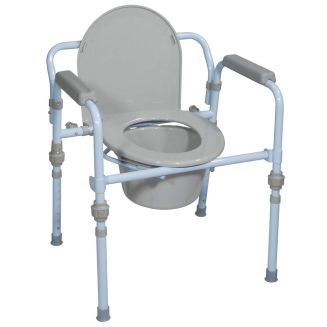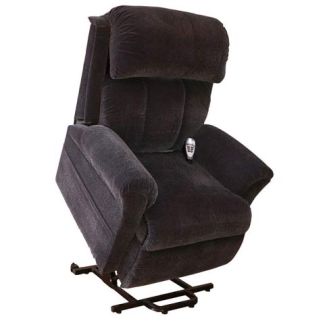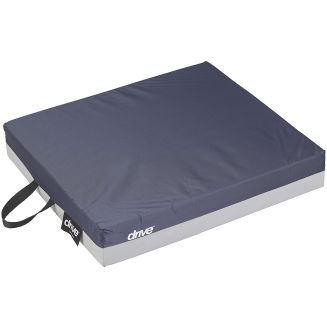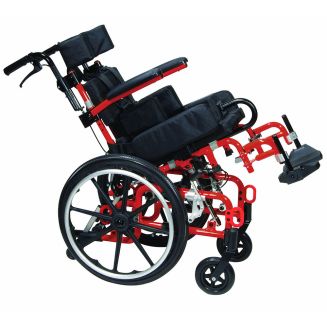Wheelchair and Scooter Ramps
Assistive handicap ramps are gradually inclined surfaces that allow mobility devices to navigate otherwise inaccessible terrain (e.g. curbs, stairs, etc.) Generally, ramps are distinguished by their rise, length, weight capacity, and width. These cooperative products can assist manual wheelchairs, power chairs, scooters, and more.
Rise: Rise is a vertical measurement from the starting point to apex height.
Length: Measurement of overall length, correlates directly with rise.
Weight Capacity: Gross weight that the device can hold reliably. Add the total weight of the wheelchair/scooter to that of the user, then make sure the resulting number is lower than the wheelchair ramp’s weight capacity. Generally, our ramps can accommodate between 600 and 700 lbs.
At 1800wheelchair, we have the wheelchair or scooter ramp for you -- and our prices won’t break the bank! Order online or give us a call at 1-800-320-7140; our phone agents are standing by to answer any questions you may have.
Remember, orders over $59 qualify for free shipping!
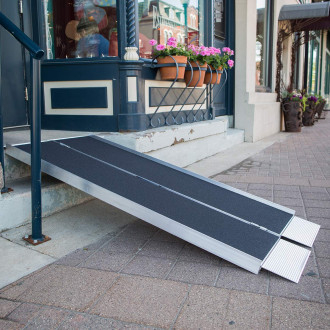
Top 10 Wheelchair Ramps
Whether you are in a wheelchair, electric, wheelchair, mobility scooter or you have difficulty navigating stairs outdoors or in your home, a wheelchair ramp may be the solution for you. Wheelchair and scooter ramps ensure that you are able to navigate terrain that would otherwise be off-limits because of stairs, curbs, inclines, and doorways. While publicly accessible buildings are required to have permanent handicap ramps or lifts, portable or folding ramps are often necessary for home use, as well as for travel and transport. In this article, we will help you understand what ti look for in a wheelchair ramp, the different types of wheelchair ramps, and the top 10 wheelchair ramps we recommend from years of experience.
Today in the United States, wheelchair ramps are required in all new construction for public accommodations thanks to The Americans With Disabilities Act. The Senate originally passed the ADA on September 7, 1989 with a vote of 76 yeas to just 8 nays. Although it might be hard to imagine today, it was soon passed by the House of Representatives on May 22, 1990 by a unanimous voice vote.
The ADA requires that ramps exceeding 30 feet must feature an intermediate platform for ease of use. Whether they're outdoor or indoor wheelchair ramps, they must also have a minimum width of 36 inches. In addition, to meet ADA Ramp Guidelines, there must be handrails between 34 and 38 inches in height on both sides of handicap ramps.
Will Medicare assistance in purchasing a portable wheelchair ramp?
Unfortunately, the answer is no, whether you are in a skilled nursing facility or living at home. See Medicare guidelines on ramps here. Medicare and Insurance will only pay for mobility equipment that your doctor deems a “medical necessity”, unfortunately ramps do not fall into this category. These are some of the most popular mobility products that are covered under medicare and Insurance (if your doctor deems them a medical necessity): canes, walkers, wheelchairs, power wheelchairs, hospital beds and patient lifts.
The good news is, you can purchase a discount ramp for your home, and we make it easy and affordable for you to choose the top 10 wheelchair ramps for you and your needs.
There are 3 types of ramps:
-
Threshold Ramps
Threshold ramps are designed for doorways, slightly raised (0.5” - 6”) landings and shorter curbs for both indoor and outdoor use They are usually made out of a non slip rubber or aluminum, but provide a sturdy, reliable incline for all types of wheelchairs and scooters. We recommend they have some non-slip component to them.
Tip: most threshold ramps to not have a height adjustment so make sure to buy the correct size for the height of your threshold. - Folding / Portable Stair Ramps
Folding ramps have a wide variety of uses at home, in the office, and while traveling. They can allow you to navigate through doorways, onto curbs, or up stairways. The main difference between these and other types of ramps, though, is their portability. Most are very lightweight and all fold up for easier travel. You can even carry some just like a suitcase! Many of these ramps offer superior non-slip grip and are incredibly durable and strong. Whether you intend to use them indoors or out, they’re a safe and sturdy option when you’re on-the-go. If you’re a frequent traveler or are looking for mobile peace of mind in any situation, folding ramps can be an excellent solution.
Ramp sizes range from 2 - 10 feet long. - SUV and Van Ramps
If you need to get in and out of a SUV or a Van these are the ramps you need to be looking at some will attach to the vehicle and other ramp just rest on the vehicle as you roll in and out. Tip: when buying a portable Vehicle ramp you may want to have a ramp, such as the EZ-Access Trifold Series that has an option of a “lip extension” which increases the lip of your ramp from 6” to 9”. - Aluminum Ramps
Probably the most-recognized type of outdoor/indoor wheelchair ramps, aluminum ramps come in several different lengths and can easily be configured to your home’s specifications. They can be made into small threshold ramps or extend the entire length of a staircase or walkway. They’re easy to install and have virtually no maintenance requirements. Unlike wood or other materials, they will not rot or corrode, which means they’ll stand up to the elements. These mobility and scooter ramps manage to be both lightweight and durable; they’re sturdy enough to handle virtually any type of wheelchair or scooter.
Here are some considerations you should have in mind when buying a ramp:
Figuring out how steep a wheelchair ramp can be before it’s too steep varies on several factors.
- How is the end user going up/down the ramp?
- What type of equipment/mobility device are they using?
- Will the end user be using the ramp independently, or will they have a caregiver?
How is the end user going up/down the ramp?
Consider who and how the end user is going up the ramp. If the end user has trouble walking up and down stairs and needs a ramp to make it easier, the ramp can probably be steeper than someone who is using a motorized wheelchair or scooter.
What type of equipment/mobility device is the user using?
If the user is using a manual wheelchair and is self propelling they will want a longer ramp with a lower incline slope as opposed to if they are in a power wheelchair or a motorized scooter, the ramp can be shorter.
Will the end user be using the ramp independently, or will they have a caregiver?
If the end user will be self propelling in their wheelchair they will want a longer ramp. If they are being pushed by a caregiver, especially if the caregiver is on the older side, then a longer ramp (one foot for every foot in height) is best.
- EZ-Access Threshold Ramp - 100% Recycled Material
- Adjustable Threshold Height - Adjustable Threshold Ramp
- BigHorn Threshold Ramp - 100% Recycled / Color Options
- Drive Single Fold Ramp - Economy Ramp
- HD Ramp - Can Accommodate 800 Lbs.
- DecPac Personal Portable Wheelchair RampLight / Foldable
- Carbon Fiber Folding Ramp - Lightest Ramp in the World!
- DePac - Super Compact Ramp - Tightest Folding Ramp
- PVI Rear Door Van Ramp - Vehicle Ramp
- EZ Access Trifold Ramp - As Long as 10 Feet!
We believe that you deserve reliable access in any situation. Whatever type of mobility ramp you require, our vast selection ensures that we have one (or several!) that will fit your needs. For more information about our selection of outdoor and indoor wheelchair ramps, contact us today.
